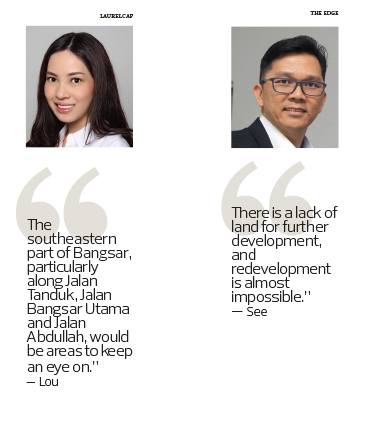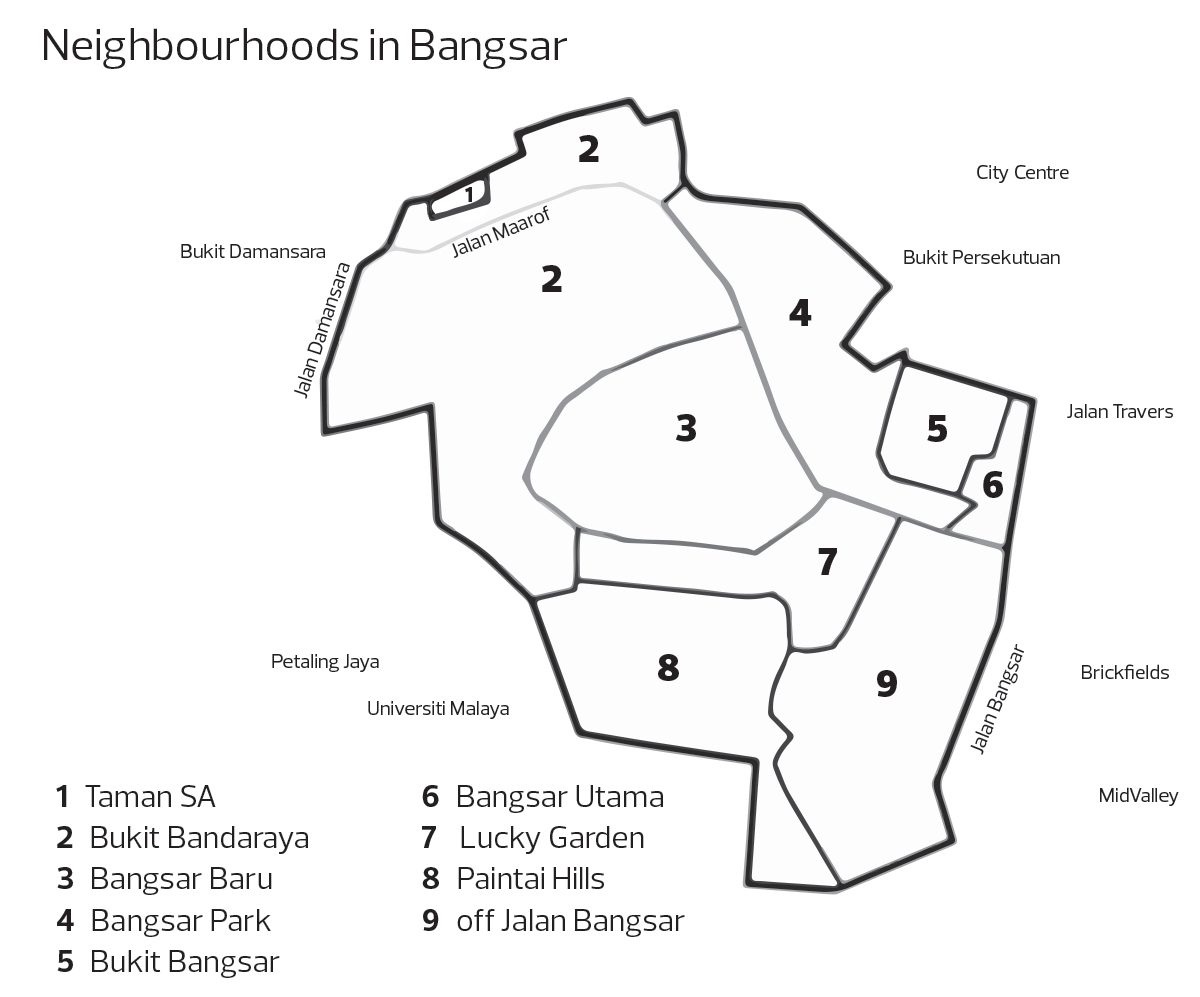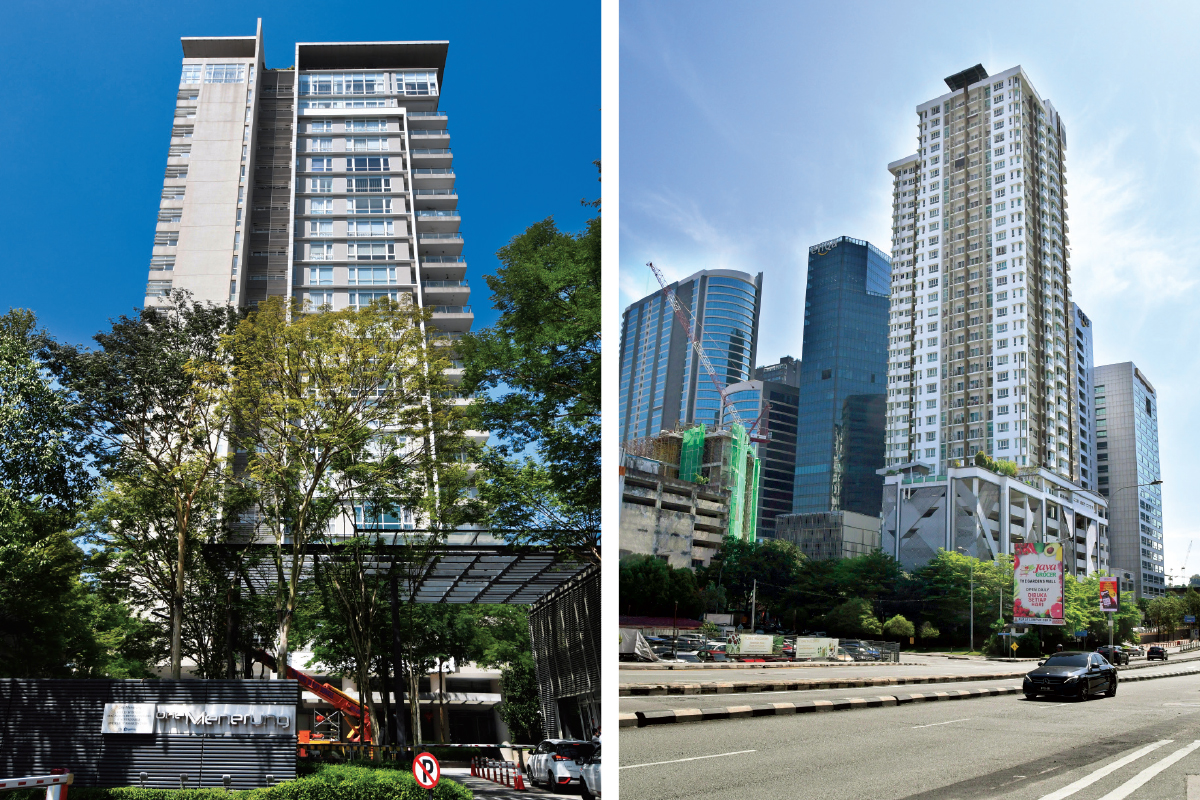
The affluent area comprises a good mix of landed and non-landed properties, as well as commercial ones (Photo by Low Yen Yeing/The Edge)
This article first appeared in City & Country, The Edge Malaysia Weekly on January 24, 2022 - January 30, 2022
Perceived as one of the key residential suburbs in the southwest of Kuala Lumpur, Bangsar is still full of life amid the current challenges.
Despite the Covid-19 pandemic and multiple iterations of the Movement Control Order (MCO) over the past two years, the upscale suburb continues to buzz with traffic and consistent footfall as people head for hang-out spots such as Burrow KL (for its fresh canelés) and Roberto’s 1020 (for its authentic Tuscan and Emilian dishes).
Bangsar is a hotspot for business and leisure. Its offerings range from retail malls such as Bangsar Shopping Centre, Bangsar Village and Bangsar Village 2 and cafés like Jaslyn Cakes, Lisette’s Café & Bakery and VCR Bangsar to designer boutiques such as Nurita Harith, art galleries, restaurants and watering holes like Mantra Bar KL and Coley.
Due to Bangsar’s enduring charm, the values of properties there have consistently appreciated over the years. Laurelcap Sdn Bhd head of capital markets Lou Minn Yian says, “Bangsar is still very much a sought-after address, as evidenced by the many developers searching for land bank in the area due to high demand and branding. The area has a strong association with success and affluence.”
The residential suburb comprises a good mix of landed and non-landed properties, as well as commercial ones. Luxury bungalows and condominiums often occupy the hillier terrain.
“The terraced houses in Bangsar that were built in the 1960s were sold for about RM18,000 in those days. Today, some of them are going for RM2 million or more,” says Lou.
Metro Homes Realty Bhd executive director See Kok Loong opines, “Bangsar attracts both investors and owner-occupiers, including those looking to upgrade to high-end real estate. For investments, the returns are high and vacancy rates are low as Bangsar is one of the preferred areas for expatriates as well.”
Bangsar started out as a rubber plantation 50 years ago. British-owned company Kuala Lumpur Rubber Co Ltd saw an opportunity and decided to plant rubber trees to capitalise on the rapidly growing demand for the commodity.
“This was spurred by the rapid growth of motor vehicles in Malaysia and the rubber needed for tyres, hoses and seals,” says Lou.
“The rubber estate where Bangsar is now located was named after two of KL Rubber Co’s board members, Edouard Bunge and Alfred Grisar. Their names were [combined] and it became known as the Bunge-Grisar rubber estate, which often contracted to Bungsar estate, and eventually became today’s well-known Bangsar.”
The plantation was eventually taken over by Belgian rubber and palm oil company Socfin. The rubber factory itself was located where the new Pavilion development is being constructed in Damansara City. The rubber plantations were sold in 1962, for about RM5,000 per acre, to two property companies, Bandar Raya Developments Bhd (now known as BRDB Developments Sdn Bhd) and Bangsar Hill Developments, which started building residential properties in the area, says Lou.
Metro Homes’ See says, “The Bangsar Baru neighbourhood, comprising 1,125 houses and a thriving business community, was developed by Eng Lian Enterprise Sdn Bhd in 1974. The 1970s witnessed Bangsar turning into a housing suburb catering to the baby boomers settling down in KL.”
Subsequently, as the next generation grew up and formed part of the city’s youth, Bangsar became a sought-after place in the 1980s with companies such as Lever Brothers and Sistem Televisyen Malaysia Bhd contributing to the demographic development, he adds.
Bangsar is about 4km away from KL city centre and is part of the Lembah Pantai parliamentary constituency, hence it is administered by Kuala Lumpur City Hall (DBKL). The area is located to the north and south of Pantai Dalam and Damansara respectively and is bordered by Jalan Bangsar and Jalan Pantai Baharu (to the south), the University of Malaya (to the west), Jalan Damansara (to the north) and Bukit Persekutuan (to the east).
Spurring values and demand
Bangsar is divided into a few neighbourhoods, namely Bangsar Baru, Bukit Bangsar, Bangsar Park, Bukit Bandaraya, Taman SA, Bangsar Utama, Lucky Garden, Pantai Hills and the areas off Jalan Bangsar. The residential suburb’s main thoroughfare is Jalan Maarof. Bukit Bangsar, Bangsar Park, Taman SA, Bangsar Utama and half of Bukit Bandaraya are located on the east side of Jalan Maarof while the other neighbourhoods are on the west side.
Laurelcap’s Lou notes, “The southeastern part of Bangsar, particularly along Jalan Tanduk, Jalan Bangsar Utama and Jalan Abdullah, would be areas to keep an eye on. The trend of development is moving towards that direction.”
It appears that landed homes, particularly terraced units, are still quite popular in Bangsar. “From our research, we have seen an increase in demand for terraced houses from 2019 onwards, while bungalow/detached houses have seen a slight decline over the last two years. Condominiums have also seen a slight increase in demand since 2019,” she says.
See opines that condominiums are the most preferred type of properties in Bangsar. “The demand for all types of properties remains strong in Bangsar. However, the most preferred are currently high-rises, as security is a top priority now.”
Some of the recent transactions of condominium units in Bangsar include those at Suasana Bangsar Condominium in Lorong Kaloi, Bangsar Heights in Jalan Tandok and Palmyra Bangsar in Jalan Medang Tandok, which fetched prices ranging from RM1.15 million to RM3.4 million, he adds.
Landed residential units can fetch RM736 psf onwards, with an average rent of RM2.40 psf per month and a yield of 3.9%, says Lou. “For non-landed units, the average price is from RM718 psf, with an average rent of RM2.80 psf per month and a yield of about 4.6%.”
For commercial units, the average price is RM1,141 psf, with an average rent of RM5.50 psf per month and yield between 5.5% and 6%, she adds.
Meanwhile, developments are still coming up in Bangsar despite the scarcity of land and sluggish market. A noteworthy project is BRDB Development’s One Eleven Menerung, which will be launched next month.
Slated for completion in 2026, the 23-storey tower will sit atop a 0.83-acre freehold site next to the Pusat Bandar Damansara MRT station. The low-density residential project will have 111 units, with built-ups ranging from 997 to 3,705 sq ft and selling prices starting from RM1,800 psf.
Lou highlights a newly-launched project — Alfa Bangsar, a 42-storey mixed-use development that comprises a hotel, serviced apartments and retail units, by City Motors Group of Companies.
“The site is located in Jalan Tandok, off Jalan Maarof. The hotel will occupy 10 floors, with 220 rooms, and the serviced apartments will take up 24 floors and comprise 178 units. There will be retail units on the podium level as well.”
The RM450 million development is located next to Hap Seng Land’s Nadi Bangsar and is due for completion in 2023.
She also highlights a 32-storey serviced apartment project, comprising 172 units, by Mega Capital Development Sdn Bhd that is along Jalan Abdullah.
See says another upcoming project in Bangsar is serviced apartment 38 Bangsar by UDA Holdings Bhd. The leasehold development is situated between Lorong Maarof and Jalan Bangsar Utama, and will comprise 281 units, with built-ups ranging from 580 to 1,442 sq ft and prices from RM758,000 to RM1.9 million.
“Setia Federal Hill by S P Setia Bhd is a big upcoming project. It is located between Bangsar and Federal Hill,” he adds.
“Another upcoming development is a 57-storey serviced apartment with 812 units in Bangsar Hill Park by Bangsar Hill Park Development Sdn Bhd. It is a redevelopment of the Bangsar Utama KTMB Quarters. There is also a mixed-use commercial development on Lot 20001 along Jalan Riong, by PHB Bhd,” says Lou.
Land scarcity and outlook
In the long term, there are several factors that will boost values in Bangsar, say the consultants. “In terms of key drivers, the land titles there are freehold and the demographic is affluent. There is also a good road network to major highways such as the Federal Highway, Sprint Expressway and Kerinchi Link,” says Lou.
Connectivity-wise, Bangsar LRT Station on the Kelana Jaya Line is located in Jalan Bangsar, apart from other nearby stations such as the Kerinchi, Universiti and Abdullah Hukum LRT stations. Bangsar is connected via the Federal Highway, Sprint Expressway, New Pantai Expressway, New Klang Valley Expressway and Damansara-Puchong Expressway.
“The [strategic] location of Bangsar is key, plus it is an upmarket neighbourhood,” says See.
Being an affluent residential suburb, however, there are a few issues. “One of the key challenges in Bangsar would be security. There have been a lot of robbery and snatch theft cases. There are also fewer gated-and-guarded landed developments as well as a lack of green space,” says Lou.
See points out the land scarcity issue in Bangsar. “There is a lack of land for further development, and redevelopment is almost impossible because of the land law that states in order to redevelop an old building, it needs 100% ownership [which is unlikely for a strata development with multiple owners].
“There are not many lots [of land] left that are undeveloped in Bangsar. There is only a small parcel in Jalan Penaga for a bungalow development and one or two lots in Jalan Kapas for a high-rise development.”
Lou concurs with See. “There is not much available land left for development in Bangsar apart from vacant bungalow lots, especially in the Medang Tanduk area. Any residual development land in Bangsar would belong to developers with previous projects in the area such as BRDB Developments and Eng Lian.”
Nonetheless, the consultants appear sanguine about Bangsar’s overall outlook.
“Properties in the area have seen a moderate increase in values over the last 10 years. And despite the pandemic, we have witnessed stable values. Moving forward, I envisage property prices in Bangsar remaining strong,” says Lou.
“The outlook is good for Bangsar. Values may stabilise in the next one to two years because of the pandemic and weak economic conditions. But in the mid-term, the market will improve and appreciate further,” says See.
Save by subscribing to us for your print and/or digital copy.
P/S: The Edge is also available on Apple's App Store and Android's Google Play.
- Trump pauses higher duties on most nations, hikes China tariffs to 125%
- AMMB, KIP REIT, Khee San, Sapura Energy, Jati Tinggi, AWC, Hibiscus Petroleum, HHRG
- Bessent sees a deal with allies, then group approach on China
- US business council urged to tell Washington tariffs can jeopardise US business ops in Asean, says Amir Hamzah
- How Malaysia’s manufacturing industries can survive Trump’s reciprocal tariff
- Record US trading day fuels S&P 500’s best rally since 2008
- Trump pauses higher duties on most nations, hikes China tariffs to 125%
- Asean emerges as a central player in global economy after overcoming series of adversities — Anwar
- Spain pushing for EU pivot to China to counter Trump tariffs
- Spain defends closer trade ties with China after US warns against 'cutting own throat'






